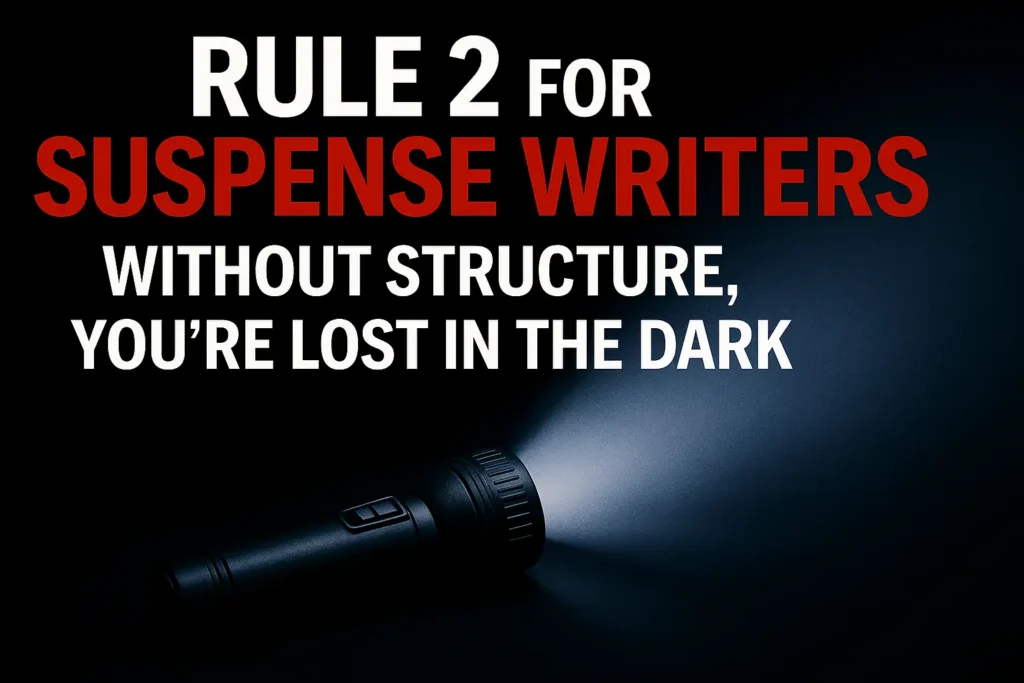
Rule #2 out of 10 for Suspense Club: Build the Bones Before You Break Them

- ~5 min read
Rule #2 out of 10 for Suspense Club: Build the Bones Before You Break Them

Let’s get one thing straight: you are not writing a poem. You’re building a story trap. And if the bones don’t hold, the whole damn thing collapses.
This is Rule #2 of Suspense Club: Build the Bones Before You Break Them.
If you’re writing a suspense story and you’re just “seeing where it goes,” you’re not writing. You’re wandering. And suspense doesn’t reward wanderers. It rewards architects. Saboteurs. Writers who plan tension like they’re planting landmines.
If you’re not planning your beats, you’re not writing a thriller. You’re just typing. Sure, you can wing it. You can vibe your way through Chapter One, invent a twist in Chapter Six, and hope the magic shows up by Chapter Twelve. But somewhere around Chapter Thirteen? You’ll hit the wall. Your villain suddenly needs a backstory. Your twist kills your setup. Your momentum disappears. And now you’re not writing — you’re backtracking, rewriting, and second-guessing everything.
It’s like flying blind in the dark. You don’t know where you are. You don’t know where you’re going. And the longer you stay airborne, the more lost you get. There’s a reason pilots go through an exhaustive checklist before takeoff — because once you’re in the air, it’s too late to realize the fuel tank is leaking.
Planning is not the enemy of creativity. It’s the accelerator. The cheat code. The map through the fog. It’s how you avoid painting yourself into a corner you can’t write your way out of.
Still not convinced? Let’s look at the pros — the Story Engineers. Dan Brown wrote an 80-page outline before writing The Da Vinci Code. James Patterson drafts 50-page blueprints before writing a single chapter. Ken Follett plans every single beat. Aaron Sorkin won’t touch a scene until he knows what each character wants and what’s at stake. These aren’t amateurs. These are professionals. They don’t guess. They design.
I know what some writers are thinking: “But I like to write by instinct. I follow the vibe and see where it goes.” That’s fine, but you’re not writing jazz. You’re wiring a bomb. And you don’t want that bomb to go off in your face. You want it to go off in your story — big, precise, devastating. Plotting isn’t about control. It’s about combustion. If you want your story to explode off the page, you need to wire it right.
You don’t need to paint by numbers, but you do need a frame to paint on. Whether it’s The Hero’s Journey, Save the Cat, the Three-Act Structure, or Dan Harmon’s Story Circle, use something to map your beats before you write. These frameworks aren’t rules to follow. They’re scaffolding to climb. They help you see the arc, spot where tension dies, and avoid painting yourself into a plot corner. You can bend the bones later — but first, you have to build them.
And I’ll be honest. I didn’t figure this out the easy way.
When I started writing Escape From Somalia, I had a great concept: Air Force One crash-lands in Somalia. The President survives. He’s alone. No backup, no comms. And the Vice President might be plotting a coup. That was it. That was my spark. I was excited. I started writing.
And then I hit the wall.
After ten chapters, I realized I was flying blind. The tension was inconsistent. The pacing was off. I kept rewriting, redrafting, trying to fix scenes that didn’t connect. That’s when I learned — painfully — that planning is everything in suspense.
So I stopped. I backed up. I grabbed a wall full of yellow sticky notes and started moving scenes around. I used Freeform on my Mac (or Miro if you’re on a PC) to lay out every chapter, every beat. I mapped the story visually — chapter by chapter. I even gave each chapter a title instead of a number to capture its tone and tension. Titles like Barbarians at the Plane and Clear and Presidential Danger. Each one was a mini-movie. Each one had a hook and a gut punch.
Inside each chapter, I laid out the beats: where it starts, what changes, and how it ends — with pressure, a twist, or a cliffhanger. And when I finally sat down to write again, I wasn’t guessing. I was hunting.
If you’re still telling yourself that planning kills the spark, stop. Planning isn’t a prison. It’s a catapult.
So build your bones. Then break them. But don’t you dare skip them.
This is Suspense Club. We don’t write fluff. We write fire.
Want help building your bones? I’m launching Suspense Club and looking for the first writers to join. If your story gets approved, I’ll coach you one-on-one — no charge, no catch, no credit card. Just a rebellion against bad writing.
Apply now at SuspenseClub.com
Let’s plot your chaos — the right way.